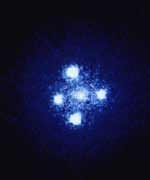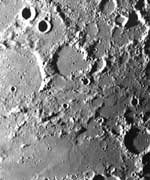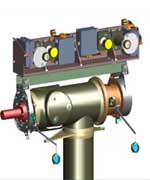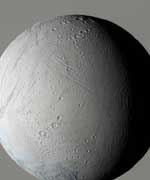
Image credit: Hubble
Spiral galaxy PGC 69457 is located near the boundary of fall constellations Pegasus and Aquarius some 3 degrees south of third magnitude Theta Pegasi – but don’t dig out that 60mm refractor to look for it. The galaxy is actually some 400 million light years away and has an apparent brightness of magnitude 14.5. So next fall may be a good time to hook up with that “astro-nut” friend of yours who is always heading off into the sunset to get well away from city lights sporting a larger, much larger, amateur instrument…
But there are plenty of 14th magnitude galaxies in the sky – what makes PGC 69457 so special?
To begin with most galaxies don’t “block” the view of an even more distant quasar (QSO2237+0305). And should others exist, few have just the right distribution of high-density bodies needed to cause light to “bend” in a way that an otherwise invisible object is visible. With PGC 69457 you get not one – but four – separate 17th magnitude views of the same quasar for the trouble of setting up one 20 inch truss tube dobsonian. Is it worth it? (Can you say “quadruple your observing pleasure”?)
But the phenomenon behind such a view is even more interesting to professional astronomers. What can we learn from such a unique effect?
The theory is already well established – Albert Einstein predicted it in his “General Theory of Relativity” of 1915. Einstein’s core idea was that an observer undergoing acceleration and one stationary in a gravitational field could not tell the difference between the two on their “weight”. By exploring this idea to its fullest, it became clear that not only matter but light (despite being massless) undergoes the same sort of confusion. Because of this, light approaching a gravitational field at an angle is “accelerated toward” the source of the gravity – but because the velocity of light is constant such acceleration only effects light’s path and wavelength – not its actual speed.
Gravitational lensing itself was first detected during the total solar eclipse of 1919. This was seen as a slight shift in the positions of stars near the Sun’s corona as captured on photographic plates. Because of this observation, we now know that you don’t need a lens to bend light – or even water to refract the image of those Koi swimming in the pond. Light like matter takes the path of least resistance and that means following the gravitational curve of space as well as the optical curve of a lens. The light from QSO2237+0305 is only doing what comes naturally by surfing the contours of “space-time” arcing around dense stars lying along the line of sight from a distant source through a more neighboring galaxy. The really interesting thing about Einstein’s Cross comes down to what it tells us about all the masses involved – those in the galaxy that refracts the light, and the Big One in the heart of the quasar that sources it.
In their paper “Reconstruction of the microlensing light curves of the Einstein Cross” Korean astrophysicist Dong-Wook Lee (et al) of Sejong University in association with Belgian astrophysicist J. Surdez (et al) of the University of Liege, found evidence of an accretion disk surrounding the black hole in Quasar QSO2237+0305. How is such a thing possible at the distances involved?
Lenses in general “collect and focus light” and those “gravitational lenses” (Lee at al posit a minimum of five low-mass but highly condensed bodies) within PGC 69457, do the same. In this way, light from a quasar that would normally travel well away from our instruments “wraps around” the galaxy to come toward us. Because of this we “see” 100,000 times more detail than otherwise possible. But there is a catch: Despite getting 100,000 times more resolution, we still only see light, not detail. And because there are several masses refracting light in the galaxy, we see more than one view of the quasar.
To get useful information from the quasar, you have to collect light over long periods of time (months to years) and use special analytical algorithms to pull the resulting data together. The method used by Lee and associates is called LOHCAM (LOcal Hae CAustic Modeling). (HAE itself is an acronym for High Amplification Events). Using LOHCAM and data available from OGLE (Optical Gravitational Lensing Experiment) and GLIPT (Gravitational Lens International Time Project), the team determined not only that LOHCAM works as hoped but that QSO2237+0305 may include a detectable accretion disk (from which it draws matter to power its light engine). The team has also determined the approximate mass of the quasars black hole, the size of the ultraviolet region radiating from it, and estimated the transverse motion of the black hole as it moves relative to the spiral galaxy.
The central black hole in Quasar QSO2237+0305 is thought to have a combined mass of 1.5 billion Suns – a value rivaling those of the largest central black holes ever discovered. Such a mass number represents 1 percent of the total number of stars in our own Milky Way galaxy. Meanwhile and by comparison, QSO2237+0305’s black hole is roughly 50 times more massive than that in the center of our own galaxy.
Based on “double-peaks” in luminosity from the quasar, Lee et al used LOHCAM to also determine the size of QSO2237+0305’s accretion disk, its orientation, and detected a central obscuration region around the black hole itself. The disk itself is roughly 1/3rd of a light year in diameter and is turned face on towards us.
Impressed? Well let’s also add that the team has determined the minimum number of microlenses and related masses found in the lensing galaxy. Depending on transverse velocity assumed (in LOHCAM modeling), the smallest range from that of a gas giant – such as the planet Jupiter – through that of our own Sun.
So how does this “hole” thing work?
The OGLE and GLIPT projects monitored changes in the intensity of visual light streaming to us from each of the four 17th magnitude views of the quasar. Since most quasars are unresolvable,due to their great distances in space, by telescope. Fluctuations in luminosity are seen only as a single point of data based on the brightness of the entire quasar. However, QSO2237+0305 presents four images of the quasar and each image highlights luminosity originating from a different perspective of the quasar. By telescopically monitoring all four images simultaneously, slight variations in image intensity can be detected and recorded in terms of magnitude, date, and time. Over several months to years, a considerable number of such “high amplification events” can occur. Patterns emerging out of their occurrence (from one 17th magnitude view to the next) can then be analyzed to show motion and intensity. Out of this a super high resolution view of normally unseen structure within the quasar is possible.
Could you and your friend with that 20 inch dob-newtonian do this?
Sure – but not without some very expensive equipment and a good handle on some complex mathematical imaging algorithms. A nice place to start however might simply be to ogle the galaxy and hang with the cross for awhile…
Written by Jeff Barbour




